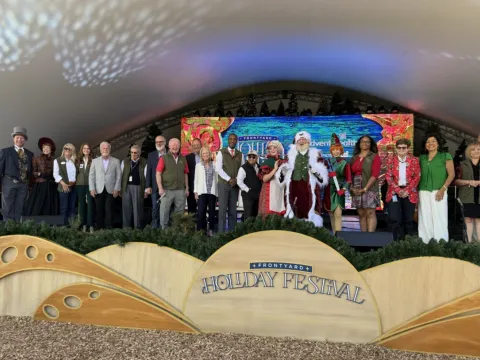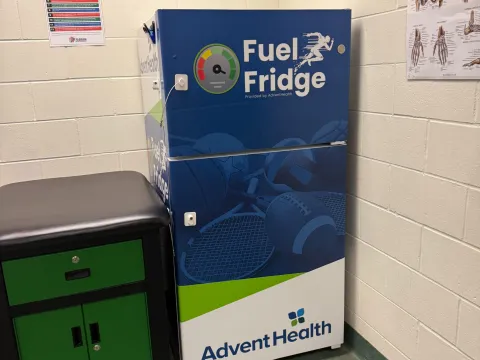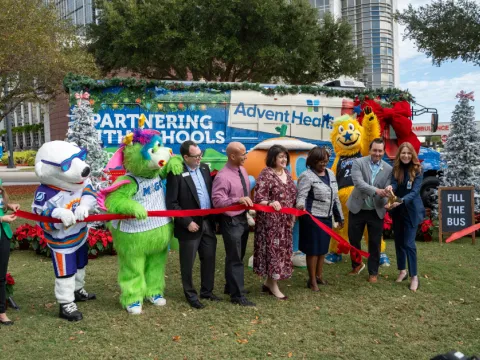- Matthew Gomez

Strokes happen suddenly and often without warning. Knowing the signs and symptoms of stroke, and what to do once you recognize them, can literally save lives.
Dr. Alkesh Brahmbhatt, NeuroScience system emergency department director at AdventHealth Orlando, shares his insights on the signs and symptoms of stroke and how important it is to get to the ER.
What are the signs and symptoms of stroke that would signal that you need to go to the ER?
Whether it’s happening to you or to someone you love, there’s a simple phrase to remember when making a potential stroke diagnosis: B.E. F.A.S.T. Knowing this phrase and the importance of each letter can be the difference between life and death.
B.E. F.A.S.T. stands for Balance, Eyes, Face, Arm, Speech and Time. Has the patient lost balance? Are their eyes clear? Quick checks of these two items could indicate a potential stroke, in which case you should call 911 or go to the emergency room (ER) immediately.
Whether it’s happening to you or to someone you love, there’s a simple phrase to remember when making a potential stroke diagnosis: B.E. F.A.S.T.
Emergency physicians are trained to recognize if a patient is having a stroke when dizziness or other abnormal symptoms are reported. One of the easiest methods for identifying a stroke is known as a F.A.S.T. exam:
- F is for face: What does your face look like? Is it asymmetrical? Is the face drooping?
- A is for arms: Can you move your arms?
- S is for speech: Are you slurring your speech or unable to talk?
- T is for time: How long have you been experiencing these issues? It’s time to call 911 or go to the ER.
Where should patients go if they believe they are having a stroke?
The ER has to be the first place patients who think they are having a stroke need to go. If you’re having a heart attack, you don’t have time to go to your primary physician. You go to the ER so we can use our lifesaving techniques. Same thing with stroke. As soon as you feel you are experiencing the signs and symptoms of stroke, go to the ER or call an ambulance to take you to the ER. The paramedics can start the protocol and alert the ER that you are coming in with slurred speech, dizziness and other subtle signs and symptoms. Once we make those determinations based on the F.A.S.T. exam, we can continue with a stroke protocol.
What can stroke patients expect to experience in the ER?
As soon as we know a stroke is a high probability, there is an immediate protocol: Code Stroke, we call it.
As soon as that happens, the patient is immediately wheeled to a team that’s ready to go with nurses on each side with IVs, doing assessments for signs of stroke. A neurologist will be there on camera observing everything to determine if there is an indication for a stroke treatment right there at the bedside. You can expect an expedited process for stroke because every second or minute of delay could advance that stroke to the point where the patient will be debilitated.
AdventHealth is comprised of free-standing ERs, hospitals and neurosurgical hubs offering specialized care. Free-standing ERs don’t have an admission level, but you can still receive treatment there for stroke. They have the medication necessary to get things started before transferring a patient to a higher level of care.
My job as Neuroscience director is to be the liaison between the ER and the neuroscience field so we can all work together and they all have a voice in the process to make it easier for patients and physicians.
The ER is the ultimate catch-all for all sorts of medical dilemmas. As we tell patients, if you have any doubts – if you’re experiencing pain, dizziness or any uneasiness with your health condition – come to the ER and we’ll make a determination about what the next levels of care may be.
Recent News
AdventHealth purchases 17 acres in DeLand
AdventHealth purchases 17 acres in DeLand

Albit Paoli, MD joins AdventHealth Medical Group Orthopedics & Sports Medicine
AdventHealth is pleased to announce that Albit Paoli, MD, has joined AdventHealth Medical Group Orthopedics & Sports Medicine at Calhoun and AdventHealth Medical Group Orthopedics & Sports Medicine at...

Dr. Phillips Center launches free Frontyard Holiday Festival supported by AdventHealth
The Dr. Phillips Center is launching its first-ever Frontyard Holiday Festival supported by AdventHealth.

AdventHealth expands access to primary care in the heart of DeLand
AdventHealth has opened a new Primary Care+ location in the heart of downtown DeLand, giving residents a simple way to get everyday care close to where life happens. The primary care practice offers...

AdventHealth Rome Turkey Trot brings community together
Over 700 people gathered on Thanksgiving morning for the AdventHealth Rome Turkey Trot, raising $15,000 for Northwest Georgia Hunger Ministries.

Fueling healthy futures for Flagler’s student athletes
Early practices, full class schedules, and evening games can push student athletes to their limits, and proper nutrition is essential to keeping them strong and focused. AdventHealth has introduced...

When seconds count: How a community of heroes saved one little girl
It was a day like any other — until the phone rang. For Ellison’s mom, that call froze time: “You need to get here right away.”

AdventHealth expands neurology services in West Volusia
Board-certified neurologist Dr. Zarmina Mufti has joined AdventHealth Medical Group and is now caring for patients at AdventHealth, expanding access to expert, whole-person neurological care for...

Central Florida organizations unite to ensure children and families facing food insecurity are fed over holiday break
AdventHealth, Orlando Magic, Florida Citrus Sports and Second Harvest Food Bank team up to support children across Orange, Osceola and Seminole counties.
Community-wide food drive launches to benefit kids in Central Florida
AdventHealth and Central Florida organizations unite to ensure children and families facing food insecurity are fed over holiday break.

Pursuing excellence in knee surgery: Colorado Joint Replacement hosts Insall Traveling Fellowship
The international program that brings leading knee surgeons together to learn, collaborate and elevate the future of joint care.

An ocean between them, and a calling that reunited them
After seven years apart, sisters Maricar Olsen and Ermeliza Ortiz were reunited in a place they both now call home. Their journey from the Philippines to Central Florida is a story of faith, family...


